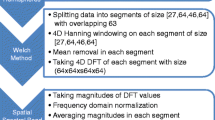Abstract
Previous studies of gender-specific differences in functional imaging during spatial and language tasks have been inconclusive. Furthermore, among women, such differences may occur during mid-luteal phase compared to the rest of the menstrual cycle. In order to examine further gender differences, functional MRI was performed in 12 male volunteers and 12 female volunteers (in the mid-luteal phase) during mental rotation and verb-generation tests. Two-sample t-tests with uncorrected P values of <0.001 for the specific regions of interest (ROIs) revealed cerebral activation differences in both stimuli. During mental rotation tests, higher levels of activation were noted in the right medial frontal, precentral, and bilateral inferior parietal cortex, while in women this occurred in the right inferior and medial temporal, right superior frontal cortex, and left fusiform gyrus. During verb-generation tests, higher levels of activation in men was found in the left medial temporal and precentral cortex. Our results indicate that differences in cerebral activity during cognitive tasks can be shown between men and women in the mid-luteal phase. Gender differences while performing a mental rotation task were more prominent than during a verb-generation task.


Similar content being viewed by others
References
Fabes RA, Shepard SA, Guthrie IK, et al (1997) Roles of temperamental arousal and gender-segregated play in young children’s social adjustment. Dev Psychol 33:693–702
Udry JR (1994) The nature of gender. Demography 31:561–573
Vawter MP, Evans S, Choudary P, et al (2003) Gender-specific gene expression in post-mortem human brain: localization to sex chromosomes. Neuropsychopharmacology 29:373–384
Herman RA, Measday MA, Wallen K (2003) Sex differences in interest in infants in juvenile rhesus monkeys: relationship to prenatal androgen. Horm Behav 43:573–583
Swaab DF, Chun WC, Kruijver FP, et al (2002) Sexual differentiation of the human hypothalamus. Adv Exp Med Biol 511:75–100; discussion 100–105
Jordan K, Wustenberg T, Heinze HJ, et al (2002) Women and men exhibit different cortical activation patterns during mental rotation tasks. Neuropsychologia 40:2397–2408
Thomsen T, Hugdahl K, Ersland L, et al (2000) Functional magnetic resonance imaging (fMRI) study of sex differences in a mental rotation task. Med Sci Monit 6:1186–1196
Rode C, Wagner M, Gunturkun O (1995) Menstrual cycle affects functional cerebral asymmetries. Neuropsychologia 33:855–865
McGowan JF, Duka T (2000) Hemispheric lateralisation in a manual-verbal task combination: the role of modality and gender. Neuropsychologia 38:1018–1027
Gur RC, Alsop D, Glahn D, et al (2000) An fMRI study of sex differences in regional activation to a verbal and a spatial task. Brain Lang 74:157–170
Shaywitz BA, Shaywitz SE, Pugh KR, et al (1995) Sex differences in the functional organization of the brain for language. Nature 373:607–609
Wisniewski AB (1998) Sexually-dimorphic patterns of cortical asymmetry, and the role for sex steroid hormones in determining cortical patterns of lateralization. Psychoneuroendocrinology 23:519–547
Hausmann M, Slabbekoorn D, Van Goozen SH, et al (2000) Sex hormones affect spatial abilities during the menstrual cycle. Behav Neurosci 114:1245–1250
Hausmann M, Becker C, Gather U, et al (2002) Functional cerebral asymmetries during the menstrual cycle: a cross-sectional and longitudinal analysis. Neuropsychologia 40:808–816
Friston KJ, Holmes AP, Poline JB, et al (1995) Analysis of fMRI time-series revisited. Neuroimage 2:45–53
Weiss EM, Siedentopf C, Hofer A, et al (2003) Brain activation pattern during a verbal fluency test in healthy male and female volunteers: a functional magnetic resonance imaging study. Neurosci Lett 352:191–194
Vingerhoets G, de Lange FP, Vandemaele P, et al (2002) Motor imagery in mental rotation: an fMRI study. Neuroimage 17:1623–1633
Podzebenko K, Egan GF, Watson JD (2002) Widespread dorsal stream activation during a parametric mental rotation task, revealed with functional magnetic resonance imaging. Neuroimage 15:547–558
Kansaku K, Yamaura A, Kitazawa S (2000) Sex differences in lateralization revealed in the posterior language areas. Cereb Cortex 10:866–872
Kansaku K, Kitazawa S (2001) Imaging studies on sex differences in the lateralization of language. Neurosci Res 41:333–337
Frost JA, Binder JR, Springer JA, et al (1999) Language processing is strongly left lateralized in both sexes. Evidence from functional MRI. Brain 122 (Pt 2):199–208
Phillips MD, Lowe MJ, Lurito JT, et al (2001) Temporal lobe activation demonstrates sex-based differences during passive listening. Radiology 220:202–207
Dietrich T, Krings T, Neulen J, et al (2001) Effects of blood estrogen level on cortical activation patterns during cognitive activation as measured by functional MRI. Neuroimage 13:425–432
Ishai A, Ungerleider LG, Haxby JV (2000) Distributed neural systems for the generation of visual images. Neuron 28:979–990
Binkofski F, Amunts K, Stephan KM, et al (2000) Broca’s region subserves imagery of motion: a combined cytoarchitectonic and fMRI study. Hum Brain Mapp 11:273–285
Georgopoulos AP, Whang K, Georgopoulos MA, et al (2001) Functional magnetic resonance imaging of visual object construction and shape discrimination :relations among task, hemispheric lateralization, and gender. J Cogn Neurosci 13:72–89
Buchel C, Josephs O, Rees G, et al (1998) The functional anatomy of attention to visual motion. A functional MRI study. Brain 121:1281–1294
Lehericy S, Cohen L, Bazin B, et al (2000) Functional MR evaluation of temporal and frontal language dominance compared with the Wada test. Neurology 54:1625–1633
Binder J (1997) Functional magnetic resonance imaging. Language mapping. Neurosurg Clin N Am 8:383–392
Author information
Authors and Affiliations
Corresponding author
Rights and permissions
About this article
Cite this article
Gizewski, E.R., Krause, E., Wanke, I. et al. Gender-specific cerebral activation during cognitive tasks using functional MRI: comparison of women in mid-luteal phase and men. Neuroradiology 48, 14–20 (2006). https://doi.org/10.1007/s00234-005-0004-9
Received:
Accepted:
Published:
Issue Date:
DOI: https://doi.org/10.1007/s00234-005-0004-9




